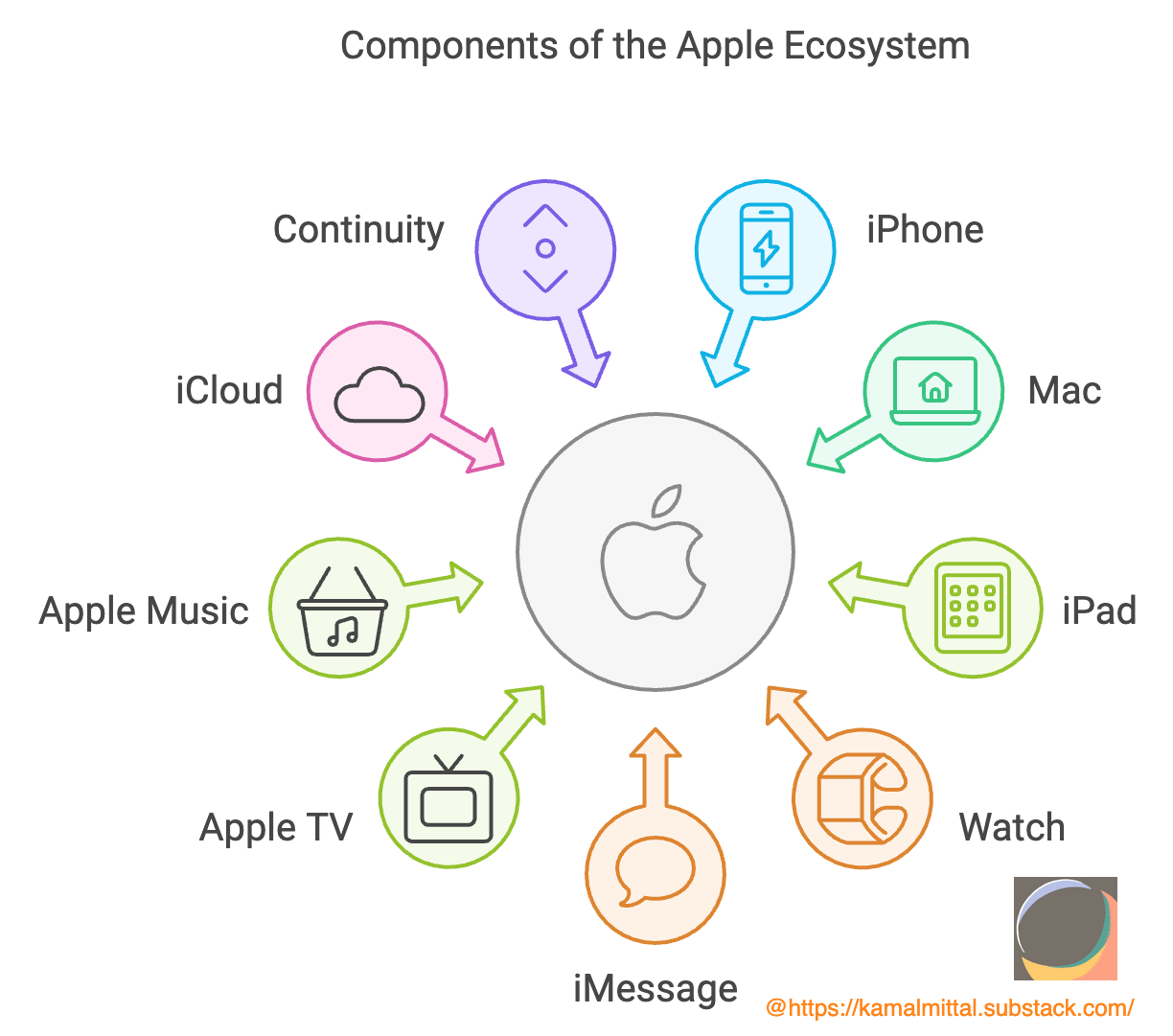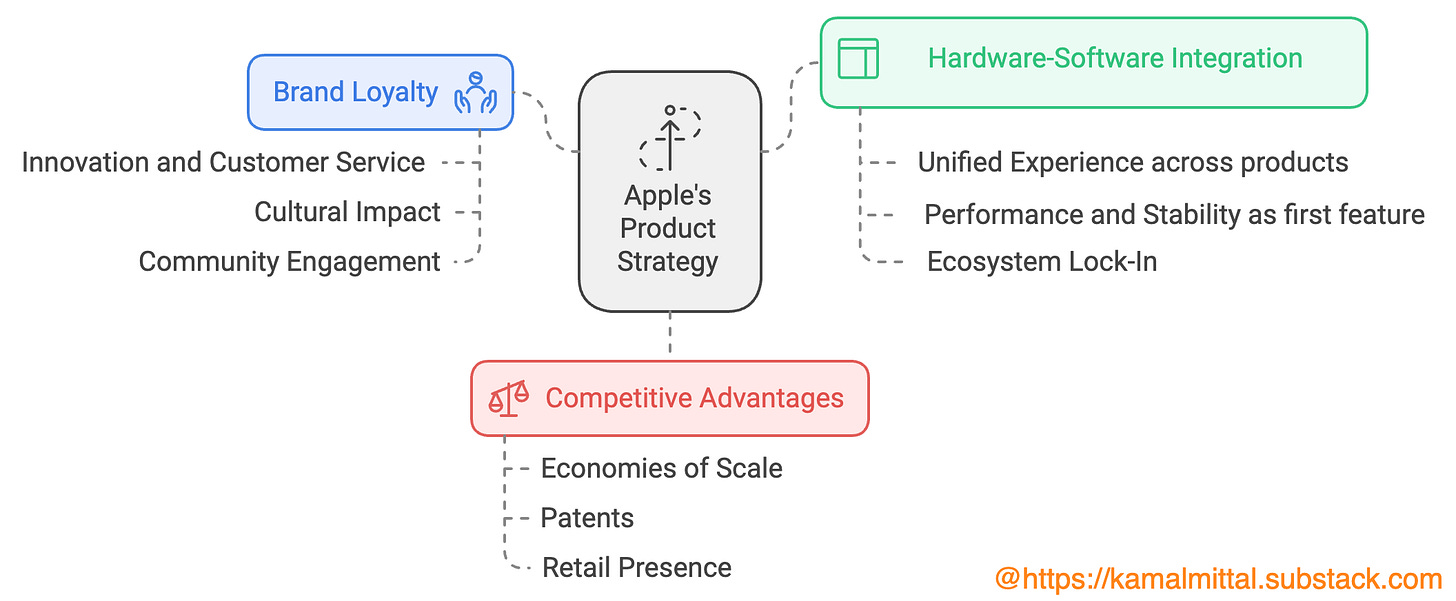Apple's Product Ecosystem and their Product Strategy
Product Sense Masterclass # 8 : Apple success is a function of Brand Loyalty, Unified Experience across Surfaces, and Competitive Advantages
Apple's leadership as one of the most successful and influential technology company is no accident. It results from meticulously crafted product management strategies that reflect an understanding of customer desires, market dynamics, and technological innovation. Product managers everywhere have much to learn from Apple’s product ecosystem and the 3 pillars of success.
1. Brand Loyalty and Community Engagement
Apple’s brand loyalty is legendary, boasting over 90% customer retention. It’s clear that Apple is not just selling products; it’s creating lifelong relationships.
Emotional Brand Connection - At its core, Apple’s success is rooted in its ability to resonate emotionally with users. Apple products are more than functional tools; they represent a lifestyle. Campaigns like "Think Different" celebrate creativity rather than just technical specifications. More recently, the "Shot on iPhone" campaign showcases real people accomplishing extraordinary things, reinforcing the idea that Apple products enable a more inspired life.
Mastering Community Engagement to drive excitement - Apple has mastered event marketing, transforming the Worldwide Developers Conference (WWDC) into a global spectacle. These events deepen emotional connections and drive customer excitement. In its WWDC 2024, Apple showcased Apple Intelligence, significant enhancements to iOS 18, iPadOS 18, macOS Sequoia, watchOS 11, and visionOS 2, all aimed at improving user personalization and privacy across its ecosystem.
Consistent Product Innovation - Apple cements this loyalty through gradual, consistent product evolution. Instead of overwhelming users with radical changes, Apple subtly improves its devices, ensuring that customers benefit from advancements without feeling alienated.
Apple as a Lifestyle Cultural Icon - Apple's products serve as status symbols; owning an iPhone or MacBook is often seen as a mark of taste and modernity. The excitement surrounding Apple product launches, where customers line up for hours, creates a sense of belonging to an exclusive community.
Exceptional Customer Service & Trust - Exceptional customer service through retail stores and Genius Bars also builds trust, ensuring users feel supported throughout their journey.
Key Takeaway for Product Managers: Building brand loyalty involves more than great product; It’s about having users excited through community engagements, connect with it emotionally and feeling personal and culturally significant. Emotional connections with users are just as important as technological innovations.
2. Hardware + Software Integration: Delivering a Superior User Experience
Apple’s control over both hardware and software is a significant competitive advantage, enabling an unmatched user experience.
Unified Experience and Seamless Integration - Once customers buy into the Apple ecosystem, leaving becomes a challenge. This loyalty stems from the seamless integration of Apple products in users’ daily lives. The synergy between an iPhone, Mac, iPad, Apple Watch makes switching to another platform feel disruptive. Customers receive a unified experience where hardware and software are designed to complement each other, making transitions between devices intuitive and reliable. Features like AirDrop, Handoff, and Continuity allow users to move seamlessly between devices, enhancing the overall experience and keeping users loyal.
Performance and Stability as the First Feature - By controlling both hardware and software, Apple optimizes performance in ways competitors cannot. The A-series chips in iPhones and iPads are custom-designed, resulting in superior speed and battery life. The M1 chip for MacBooks exemplifies this advantage, achieving significant leaps in performance and efficiency.
Ecosystem Lock-In: A Strategic Moat - Apple's strategy creates an ecosystem that makes switching feel burdensome. Services like iCloud, iMessage, and Apple Pay create conveniences that many users are reluctant to give up, fostering a strong sense of loyalty.
Key Takeaway for Product Managers: Apple demonstrates the importance of a unified product experience. Owning both hardware and software allows Apple to optimize every aspect of user experience with utmost performance and stability. Reducing friction for users is key to fostering loyalty.
3. Competitive Advantages: Building High Barriers to Entry
Apple’s strategic decisions have established significant barriers to competition, enhancing its long-term success.
Economies of Scale and Supply Chain Mastery - Apple’s mastery of economies of scale enables it to negotiate favorable deals with suppliers, lowering production costs and maintaining high-profit margins.
Intellectual Property and Patents - Apple’s extensive patent portfolio protects its innovations, preventing competitors from easily replicating its technology. This intellectual property is vital in maintaining leadership in the industry.
Direct Consumer Engagement through Retail Presence - With over 500 stores globally, Apple engages directly with customers, providing technical support, product demos, and educational workshops. This curated experience enhances customer loyalty and reinforces the brand’s commitment to care.
Key Takeaway for Product Managers: Building competitive advantages requires strategic market thinking. Whether through economies of scale, intellectual property, or consumer engagement, Apple has created barriers that are challenging for competitors to overcome.
Conclusion: Apple’s innovation, community engagement, lifestyle icon and exceptional customer support underpins its brand loyalty and emotional connections by users. The unified experience and seamless integration across hardware (different surfaces) reduces friction and ensures user lock-in with high switching cost. It has also solidified its position in the industry with sustainable competitive advantages (IP, supply chain mastery, retail presence) that are hard to overcome.



